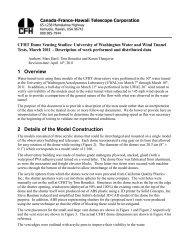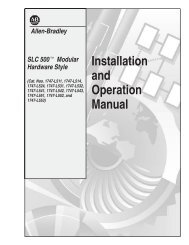Booklet ready version - Canada France Hawaii Telescope ...
Booklet ready version - Canada France Hawaii Telescope ...
Booklet ready version - Canada France Hawaii Telescope ...
Create successful ePaper yourself
Turn your PDF publications into a flip-book with our unique Google optimized e-Paper software.
Sigma Ori E is a<br />
young star with a<br />
very strong magnetic<br />
field in a tilted<br />
dipole configuration.<br />
Material blown<br />
away from the star<br />
in a wind is confined<br />
by the magnetic<br />
field, builds<br />
up, and periodically<br />
breaks out of the<br />
magnetosphere.<br />
The mass loss<br />
slows down the rotation<br />
of the star, by<br />
7 ms per year.<br />
Credit: R. Cohen.<br />
files. The information is used to reconstruct maps of the<br />
magnetic field.<br />
The second part of the LP is a Survey Component which looks<br />
for previously unknown magnetic massive stars from an initial<br />
list of about 200 stars.<br />
A little over halfway through the 9 semester program, the<br />
international collaboration has acquired over 1250 high-resolution<br />
polarized spectra of about 150 individual stars, and<br />
discovered new magnetic fields in over a dozen hot and<br />
massive stars, out of the hundred or so which have been<br />
observed so far. Other notable results include the detection of<br />
magnetic fields in the 2 most rapidly-rotating known magnetic<br />
stars, which rotate in about only half a day, and in the most<br />
massive known magnetic star.<br />
MAgnetic Protostars and Planets (MaPP)<br />
N. Manset<br />
Magnetosphere of<br />
the cTTS V2129<br />
Oph, extrapolated<br />
from the surface<br />
magnetic map derived<br />
from spectropolarimetry<br />
of<br />
both photospheric<br />
lines and accretion<br />
proxies. Open and<br />
closed field lines<br />
are in blue and<br />
white, respectively;<br />
colors at the surface<br />
depict the radial<br />
field component,<br />
with red and blue<br />
corresponding to<br />
positive and negative<br />
polarities (from<br />
Donati et al. 2007;<br />
Jardine et al.i2008)<br />
MaPP (MAgnetic Protostars and Planets) is a CFHT Large Program that investigates the role of magnetic fields<br />
in the formation of stars and planetary systems, especially stars with a mass similar to that of our Sun. MaPP<br />
focusses especially on the core regions of protostellar accretion discs - including the newly born star.<br />
Started during semester 2008B, this large program has<br />
al<strong>ready</strong> followed 15 of the 20 or so young stars on its<br />
list. By the time it ends during semester 2012B, all<br />
targets will have been followed closely, sometimes at<br />
two different epochs separated by a few years. Typically,<br />
each star is observed one or more times each night for<br />
10-16 consecutive nights, with the spectropolarimeter<br />
ESPaDOnS, allowing astronomers to map the magnetic<br />
fields as the star rotates on itself from night to night.<br />
By comparing the observations and maps of magnetic<br />
fields with the predictions of new theoretical models and<br />
magnetohydrodynamic simulations,MaPP will answer<br />
several major open questions on star formation and<br />
produce updated models incorporating the effect of<br />
magnetic fields. Al<strong>ready</strong>, MaPP has found a non-stationary<br />
magnetic field configuration on V2129 Oph,<br />
with changes noticeable within only 4 years. The magnetic<br />
field is poloidal and axisymetric, and the observations<br />
show a dark photospheric spot and a localized area<br />
of accretion-powered emission, in agreement with recent 3D magnetohydrodynamic simulations specific to<br />
this star.<br />
Variability on a timescale of one only year was also observed on AA Tau, which also has a mostly poloidal<br />
magnetic field. The circular polarization data suggest that the accreting material in the inner disk regions is<br />
mostly being expelled outward instead of getting to the surface of the star. This phenomenon in the end slows<br />
down the spin on the star.<br />
The MaPP Large Program is confirming that magnetic fields indeed play a key role in the formation and early<br />
evolution of stars, through accretion and ejection processes.<br />
8 2009 & 2010<br />
Fares R., Donati, J.-F., Moutou, C., Bohlender, D., Catala, C., Deleuil, M., Shkolnik, E., Cameron, A. C., Jardine, M. M.,<br />
<br />
1383-1391.<br />
Fathi K., Beckman, J. E., Piñol-Ferrer, N., Hernandez, O., Martínez-Valpuesta, I., Carignan, C. Pattern Speeds of Bars and<br />
<br />
<br />
chez-Portal, M. Evolution of the optical Tully-Fisher relation up to z = 1.3. A&A 496 389-397.<br />
<br />
276-283.<br />
Fossati L., Ryabchikova, T., Bagnulo, S., Alecian, E., Grunhut, J., Kochukhov, O., Wade, G. The chemical abundance analysis<br />
of normal early A- and late B-type stars. A&A 503 945-962.<br />
Freeman P.E., Newman, J. A., Lee, A. B., Richards, J. W., Schafer, C. M. Photometric redshift estimation using spectral connectivity<br />
analysis. MNRAS 398 2012-2021.<br />
Gabor J.M., Impey, C. D., Jahnke, K., Simmons, B. D., Trump, J. R., Koekemoer, A. M., Brusa, M., Cappelluti, N., Schinner-<br />
<br />
Galametz A., De Breuck, C, Vernet, J, Stern, D, Rettura, A, Marmo, C.,Omont, A, Allen, M, Seymour, N. Large scale structures<br />
around radio galaxies at z ~ 1.5. A&A 507 131-145.<br />
Gavazzi R., Adami, C., Durret, F., Cuillandre, J.-C., Ilbert, O., Mazure, A., Pelló, R., Ulmer, M. P. A weak lensing study of the<br />
Coma cluster. A&A 498 L33-L36.<br />
Gilbert K.M., Font, A.S., Johnston, K.V., Guhathakurta, P. The Dominance of Metal-rich Streams in Stellar Halos: A Compar-<br />
<br />
Gilbert K.M., Guhathakurta, P., Kollipara, P., Beaton, R.L., Geha, M.C., Kalirai, J.S., Kirby, Evan N., Majewski, S.R., Patterson,<br />
R.J. The Splash Survey: A Spectroscopic Portrait of Andromeda's Giant Southern Stream. ApJ 705 1275-1297.<br />
Gladman B., Kavelaars, J., Petit, J.-M., Ashby, M. L. N., Parker, J., Coffey, J., Jones, R. L., Rousselot, P., Mousis, O. Discovery<br />
of the first retrograde transneptunian object. ApJ 697 L91-L94.<br />
Green E.M., Dufour, P., Fontaine, G., Brassard, P. Follow-up Studies of the Pulsating Magnetic White Dwarf SDSS<br />
J142625.71+575218.3. ApJ 702 1593-1603.<br />
Grove L.F., Benoist, C., Martel, F. Galaxy clusters in the CFHTLS. II. Matched-filter results in different passbands. A&A 494<br />
845-855.<br />
Grunhut J.H., Wade, G. A., Marcolino, W. L. F., Petit, V., Henrichs, H. F., Cohen, D. H., Alecian, E., Bohlender, D., Bouret,<br />
J.-C., Kochukhov, O. and 3 coauthors Discovery of a magnetic field in the O9 sub-giant star HD 57682 by the MiMeS Collaboration.<br />
MNRAS 400 L94-L98..<br />
Harrington D.M., Kuhn, J. R. Spectropolarimetric observations of Herbig Ae/Be stars. II. Comparison of spectropolarimetric<br />
surveys: Haebe, Be and other emission-line stars. ApJS 180 138-181.<br />
Harris W.E., The Globular Cluster System in M87: A Wide-Field Study with CFHT/Megacam. ApJ 703 939-950.<br />
Hildebrandt H., Pielorz, J., Erben, T., van Waerbeke, L., Simon, P., Capak, P. CARS: the CFHTLS-Archive-Research Survey.<br />
II. Weighing dark matter halos of Lyman-break galaxies at z = 3-5. A&A 498 725-736.<br />
Holhjem K., Schirmer, M., Dahle, H. Weak lensing density profiles and mass reconstructions of the galaxy clusters Abell<br />
1351 and Abell 1995. A&A 504 1-13.<br />
Howell D.A., Sullivan, M., Brown, E. F., Conley, A., LeBorgne, D., Hsiao, E. Y., Astier, P., Balam, D., Balland, C., Basa, S.<br />
and 16 coauthors The effect of progenitor age and metallicity on luminosity and 56Ni yield in type Ia supernovae. ApJ 691<br />
661-671.<br />
Huertas-Company M., Foex, G., Soucail, G., Pelló, R. The role of environment in the morphological transformation of galaxies<br />
in 9 rich intermediate redshift clusters. A&A 505 83-96.<br />
Huertas-Company M., Tasca, L., Rouan, D., Pelat, D., Kneib, J. P., Le Fèvre, O., Capak, P., Kartaltepe, J., Koekemoer, A.,<br />
McCracken, H. J. and 3 coauthors robust morphological classification of high-redshift galaxies using support vector machines<br />
on seeing limited images.II. Quantifying morphological….. A&A 497 743-753.<br />
Hutchings J.B., Scholz, P., Bianchi, L. Environments of QSOs at Redshift 0.9-1.3. AJ 137 3533-3540.<br />
Hwang C.-Y., Chang, Ming-Yan A catalog of morphologically identified merging galaxies. ApJS 181 233-237.<br />
Ideue Y., Nagao, T., Taniguchi, Y., Shioya, Y., Saito, T., Murayama, T., Sasaki, S., Trump, J. R., Koekemoer, A. M., Aussel,<br />
H. and 7 coauthors Environmental effects on the star formation activity in galaxies at z sime 1.2 in the COSMOS field. ApJ<br />
700 971-976.<br />
Ilbert O., Capak, P., Salvato, M., Aussel, H., McCracken, H. J., Sanders, D. B., Scoville, N., Kartaltepe, J., Arnouts, S.,<br />
LeFloc'h, E. and 53 coauthors Cosmos photometric redshifts with 30-BANDS for 2-deg2. ApJ 690 1236-1249.<br />
Kavelaars J.J., Jones, R. L., Gladman, B. J., Petit, J.-M., Parker, Joel Wm., Van Laerhoven, C., Nicholson, P., Rousselot, P.,<br />
Scholl, H., Mousis, O. and 8 coauthors The <strong>Canada</strong>-<strong>France</strong> Ecliptic plane survey—L3 data release: The orbital structure of<br />
the Kuiper Belt. AJ 137 4917-4935.<br />
Kilbinger M., Benabed, K., Guy, J., Astier, P., Tereno, I., Fu, L., Wraith, D., Coupon, J., Mellier, Y., Balland, C. and 8 coauthors<br />
Dark-energy constraints and correlations with systematics from CFHTLS weak lensing, SNLS supernovae Ia and<br />
WMAP5. A&A 497 677-688.<br />
Kormendy J., Fisher, D.B., Cornell, M.E., Bender, R. Structure and formation of elliptical and spheroidal galaxies. ApJS 182<br />
216-309.<br />
Laird E.S., Nandra, K., Georgakakis, A., Aird, J. A., Barmby, P., Conselice, C. J., Coil, A. L., Davis, M., Faber, S. M., Fazio,<br />
G. G. and 4 coauthors AEGIS-X: the Chandra deep survey of the extended groth strip. ApJS 180 102-116.<br />
Lamareille F., Brinchmann, J., Contini, T., Walcher, C. J., Charlot, S., Pérez-Montero, E., Zamorani, G., Pozzetti, L., Bolzonella,<br />
M., Garilli, B. and 36 coauthors Physical properties of galaxies and their evolution in the VIMOS VLT Deep Survey. I.<br />
The evolution of the mass-metallicity relation up to z ~ 0.9. A&A 495 53-72.<br />
Landstreet J.D., Kupka, F., Ford, H. A., Officer, T., Sigut, T. A. A., Silaj, J., Strasser, S., Townshend, A. Atmospheric velocity<br />
fields in tepid main sequence stars. A&A 503 973-984.<br />
CFHT Annual Report 33




![Documentation [PDF] - Canada France Hawaii Telescope ...](https://img.yumpu.com/26965302/1/190x245/documentation-pdf-canada-france-hawaii-telescope-.jpg?quality=85)







